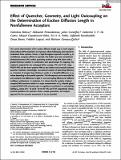Por favor, use este identificador para citar o enlazar a este item:
http://hdl.handle.net/10261/257641COMPARTIR / EXPORTAR:
 SHARE
BASE SHARE
BASE
|
|
| Visualizar otros formatos: MARC | Dublin Core | RDF | ORE | MODS | METS | DIDL | DATACITE | |

| Título: | Effect of Quencher, Geometry, and Light Outcoupling on the Determination of Exciton Diffusion Length in Nonfullerene Acceptors |
Autor: | Belova, Valentina; Perevedentsev, Aleksandr; Gorenflot, Julien; Castro, Catherine S. P. De; Casademont Viñas, Miquel; Paleti, Sri Harish Kumar; Karuthedath, Safakath; Baran, Derya; Laquai, Frédéric | Palabras clave: | Exciton diffusion lengths Light in- and outcoupling Nonfullereneacceptors Photoluminescence quenching |
Fecha de publicación: | 21-dic-2022 | Editor: | Wiley-VCH | Citación: | Solar RRL: 10.1002/solr.202100822 (2022) | Resumen: | The correct determination of the exciton diffusion length (LD) in novel organic photovoltaics (OPV) materials is an important, albeit challenging, task required to understand these systems. Herein, a high-throughput approach to probe LD in nonfullerene acceptors (NFAs) is reported, that builds upon the conventional photoluminescence (PL) surface quenching method using NFA layers with a graded thickness variation in combination with spectroscopic PL mapping. The method is explored for two archetypal NFAs, namely, ITIC and IT-4F, using PEDOT:PSS and the donor polymer PM6 as two distinct and practically relevant quencher materials. Interestingly, conventional analysis of quenching efficiency as a function of acceptor layer thickness results in a threefold difference in LD values depending on the specific quencher. This discrepancy can be reconciled by accounting for the differences in light in- and outcoupling efficiency for different multilayer architectures. In particular, it is shown that the analysis of glass/acceptor/PM6 structures results in a major overestimation of LD, whereas glass/acceptor/PEDOT:PSS structures give no significant contribution to outcoupling, yielding LD values of 6−12 and 8−18 nm for ITIC and IT-4F, respectively. Hence, practical guidelines for quencher choice, sample geometries, and analysis approach for the accurate assessment of LD are provided. | Versión del editor: | http://dx.doi.org/10.1002/solr.202100822 | URI: | http://hdl.handle.net/10261/257641 | E-ISSN: | 2367-198X |
| Aparece en las colecciones: | (ICMAB) Artículos |
Ficheros en este ítem:
| Fichero | Descripción | Tamaño | Formato | |
|---|---|---|---|---|
| Belova_SolarRRL_2021_editorial.pdf | Artículo principal | 746,62 kB | Adobe PDF |  Visualizar/Abrir |
| Belova_SolarRRL_2021_suppl_editorial.pdf | Información complementaria | 1,48 MB | Adobe PDF |  Visualizar/Abrir |
CORE Recommender
Page view(s)
52
checked on 19-abr-2024
Download(s)
107
checked on 19-abr-2024
Google ScholarTM
Check
Este item está licenciado bajo una Licencia Creative Commons

